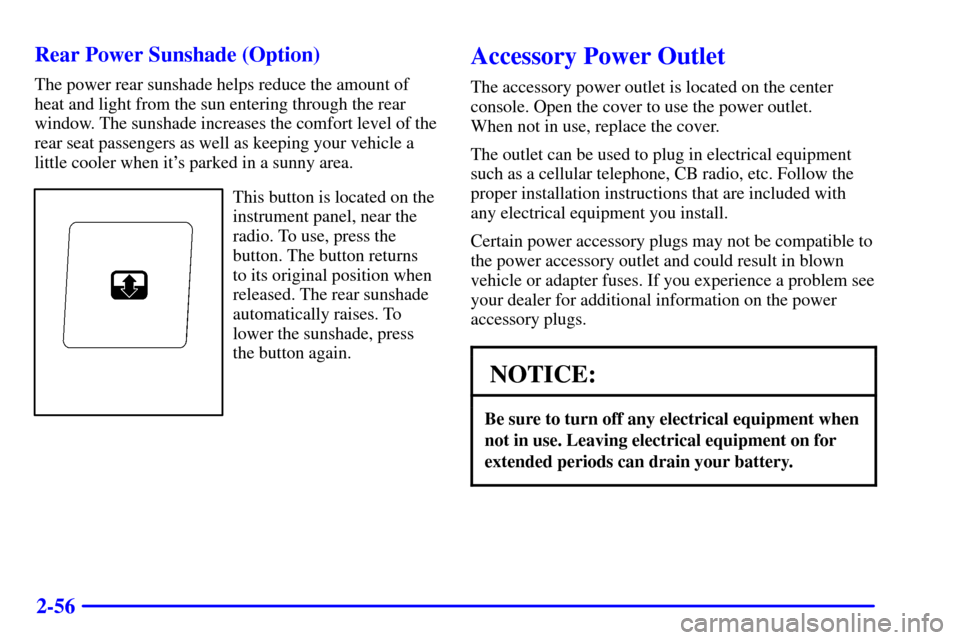Page 123 of 328

2-56 Rear Power Sunshade (Option)
The power rear sunshade helps reduce the amount of
heat and light from the sun entering through the rear
window. The sunshade increases the comfort level of the
rear seat passengers as well as keeping your vehicle a
little cooler when it's parked in a sunny area.
This button is located on the
instrument panel, near the
radio. To use, press the
button. The button returns
to its original position when
released. The rear sunshade
automatically raises. To
lower the sunshade, press
the button again.
Accessory Power Outlet
The accessory power outlet is located on the center
console. Open the cover to use the power outlet.
When not in use, replace the cover.
The outlet can be used to plug in electrical equipment
such as a cellular telephone, CB radio, etc. Follow the
proper installation instructions that are included with
any electrical equipment you install.
Certain power accessory plugs may not be compatible to
the power accessory outlet and could result in blown
vehicle or adapter fuses. If you experience a problem see
your dealer for additional information on the power
accessory plugs.
NOTICE:
Be sure to turn off any electrical equipment when
not in use. Leaving electrical equipment on for
extended periods can drain your battery.
Page 193 of 328

4-10
The traction control system automatically comes on
whenever you start your vehicle. To limit wheel spin,
especially in slippery road conditions, you should
always leave the system on. But you can turn the
traction control system off if you ever need to. You
should turn the system off if your vehicle ever gets
stuck in sand, mud or snow and rocking the vehicle is
required. See ªRocking Your Vehicleº in the Index.
To turn the system off,
press the TCS OFF button
located near the radio on
the center console.
Steering
Power Steering
If you lose power steering assist because the engine
stops or the system is not functioning, you can steer but
it will take much more effort.
Speed Sensitive Steering (SSS)
This system varies the amount of steering effort in relation
to your vehicle speed. Steering is easier at a lower speed
for maneuvering and parking ease. As your vehicle speed
increases, the steering effort also increases. At highway
speeds, the amount of steering effort is increased to
provide manual
-like steering for maximum control and
stability. If your vehicle seems harder to steer than normal
when parking or driving slow, something may be wrong
with the speed sensitive steering system. You will still
have power steering, however, steering will be stiffer than
normal at low speeds.
Page 223 of 328
5-2
Hazard Warning Flashers
Your hazard warning flashers let you warn others. They
also let police know you have a problem. Your front and
rear turn signal lamps will flash on and off.
Pressing this button on the
center console makes the
front and rear turn signal
lamps flash on and off.
The indicator light on
the button also flashes.
Pressing the button again
turns the flashers off.
Your hazard warning flashers work no matter what
position your key is in, and even if the key isn't in.
When the hazard warning flashers are on, the turn
signals won't work since they are already flashing.
Other Warning Devices
If you carry reflective triangles, you can set one up
at the side of the road about 300 feet (100 m) behind
your vehicle.
Page 257 of 328
6-6
To open your fuel door,
your vehicle must be in
PARK (P). Press the
FUEL DOOR unlock
button located on the
instrument panel center
console to unlock and
open the fuel door.
You can also press the fuel button on the remote keyless
entry transmitter to access the fuel cap.
Your vehicle has a tethered fuel cap.
To remove the cap, turn it slowly to the left
(counterclockwise). The cap has a spring in it; if you let
go of the cap too soon, it will spring back to the right.